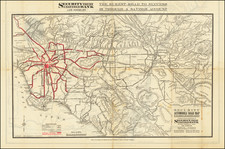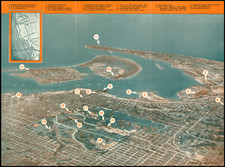The First Modern Survey of Rancho Ex Mission San Diego -- One of the Earliest Modern Surveys of San Diego
Finely executed map Rancho Ex Mission San Diego, showing the final confirmation to Santiago Arguello of what was the largest Mexican Land Grant in San Diego County and the eastern part of the future City of San Diego.
The present map is the foundational work upon which all future maps maps are based. Encompassing over 55,000 acres The Rancho Ex-Mission San Diego and Pueblo Lands of San Diego (shown to the west of this map) comprise the majority of the modern City of San Diego. The outline of the northeast shoreline of Coronado (then North Island and Coronado) can be seen at the bottom-left of the map.
As such, this is one of the foundational survey maps for over half of the modern City of San Diego..
A hand-written note in the lower-right of the map reads as follows:
The field notes of the survey of the Rancho Mission San Diego finally confirmed to Santiago Arguello, from which this plat has been made have been examined and approved and are on file in this office, the said survey having been made in conformity with the decision of the Hon. Secretary of the Interior, having date of April 19th 1876
U.S Survey General's Office
San Francisco California
July 12th 1876
H.G. Rollins, U.S. Sur Gen. Cal.
Rancho Ex- Mission San Diego
When the Spanish first settled in San Diego in 1769, Captain Vincente Vilaey recommended Mission Valley and the San Diego River as the viable site for a mission. Soon thereafter a land expedition led by Gaspar de Portola reached San Diego Bay, and would ultimately build a primitive mission and presidio structure on the hill near the river. Shortly thereafter, the site was moved further east in the valley. According to Father Junipero Serra’s first report of the Mission, “It is determined to move the Mission within the same Canada of the port toward the northeast of the presidio, at a distance of a little less than two leagues. The place is much more suitable for a population, on account of the facility of obtaining necessary water, and on account of the vicinity of good land for cultivation. The place is called Nipaguay.”
In 1822, Mexico declared its independence from Spanish rule, and San Diego became part of the Mexican Republic. Mexican independence led to the final demise of California’s mission system and in 1834, the Mexican government secularized the San Diego mission. The Act of Secularization and the Decree of Confiscation removed the administration of the mission from the Franciscans to the Mexican administrators.
The Mexican government opened California to foreign trade bringing manufactured goods from Europe in exchange for California’s cattle hides. As the hide trade grew so did the need for additional grazing lands. Privatized land grants were issued establishing the rancho system of large agricultural estates. Native Mexican Franciscan Francisco Garcia Diego y Moreno became the first Bishop of the California occupying the Mission until 1842, but only a few of the main buildings were habitable.
In 1846, Governor Pio Pico sold the lands of Mission San Diego de Alcalá to prominent Californio Santiago Arguello, a former commandante of the Presidio from 1830-1835. The land grant known as the Rancho Ex-Mission San Diego was approximately 58,875 acres. Pío Pico decreed that the mission rancho be sold to Santiago Argüello "..in consideration of past services to the territorial government." According to the terms of the 1846 deed, Argüello was required to pay the debts of the Mission, support the priests, and maintain religious services. Santiago Argüello (1791 - 1862), born at Monterey, was the son of José Darío Argüello. He held a number of political and military offices at San Diego and was commandante of the Presidio of San Diego from 1830 to 1835. In 1829 he was granted the Tia Juana Rancho, in Mexico. He aided the American cause during the Mexican-American War, was captain of a troop of the California battalion, and died at the Tia Juana Rancho in 1862.
With the cession of California to the United States following the Mexican-American War, the 1848 Treaty of Guadalupe Hidalgo provided that the land grants would be honored. As required by the Land Act of 1851, a claim for Rancho Ex-Mission San Diego was filed with the Public Land Commission in 1852, and the grant was patented to Santiago Argüello in 1876.
Santiago Argüello
The following biography is excerpted from Wikipedia's entry on Argüello:
Santiago Argüello (1791–1862) was a Californio, a soldier in the Spanish army of the Viceroyalty of New Spain in Las Californias, a major Mexican land grant ranchos owner, and part of an influential family in Mexican Alta California and post-statehood California.
Argüello was paymaster at the Presidio of San Diego in 1818, and in 1821 had a garden in Mission Valley.
Argüello took part in preparations to defend the Presidio against the 1818 Hippolyte de Bouchard Piracy Invasion but, after attacking Mission San Juan Capistrano, Bouchard bypassed San Diego and continued south into Mexico. Post-Mexican Independence (1822), Argüello was lieutenant of the San Diego Company 1827-31, and commandant from 1830 to 1835. From 1831-35, Argüello was captain of the company and took part, with his brother-in-law Agustín V. Zamorano, in the 1831 revolt against Governor Manuel Victoria. In 1833-34 he was revenue officer at San Diego.
Argüello helped the pueblo (town) of San Diego in 1835, with other soldiers. They sent a committee of five to the presidio commandant to complain of pueblo residents' hunger, lack of clothing, and back pay due - with a demand of payment to them. The commandant began to put the five soldiers in irons, but the threats of their comrades compelled him to desist. They appealed to the General, who promised justice for the residents, which he administered soon after.
Argüello was sympathetic to the United States during the Mexican-American War, providing them with considerable aid. He welcomed the stabilizing influence of the Americans, as the Mexican Alta California government was in disarray after the ouster of Governor Manuel Micheltorena in 1846.
He was a member of the U.S. California military territory legislative council in 1847, and was later made customs collector of the Port of San Diego.
Santiago Argüello died on his Rancho Tía Juana in Baja California, Mexico, in 1862. He is buried at El Campo Santo in San Diego, California. His widow María died in 1878.
Rarity
The present map is a unique or nearly unique survival. Such early, i.e., pre-1880s, manuscript surveys for Southern California are almost never encountered outside of institutional collections; in 25 years of dealing in San Diego, this is the first time we have seen such a significant American manuscript map related to the city.
The California State Library lists a map with a similar title in the Owen C. Coy Collection, 1860-1940.












![[ Burlingame / South Park Neighborhood -- San Diego ]](https://storage.googleapis.com/raremaps/img/small/100970.jpg)

![[ Before The Salton Sea ] [ Official Map of San Diego County compiled from latest official maps of U.S. surveys, railroad and irrigation surveys, county records, and other reliable sources . . . Northeast Sheet ]](https://storage.googleapis.com/raremaps/img/small/101378.jpg)